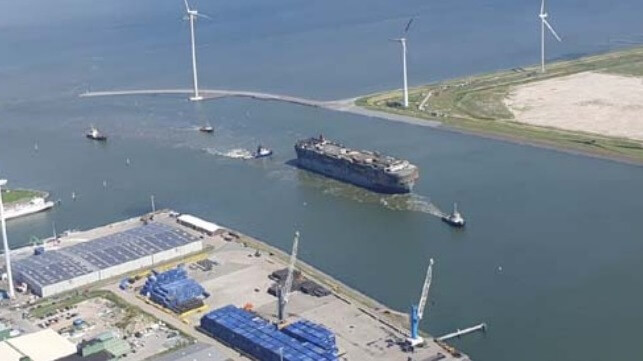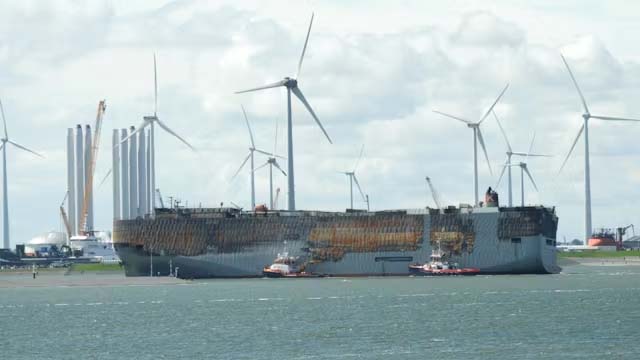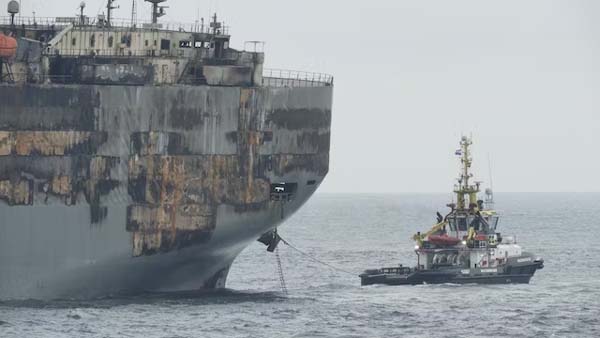Burnt-Out Fremantle Highway Arrives in Dutch Port

The burnt-out hulk of the car carrier Fremantle Highway arrived in the Dutch port of Eemshaven on Thursday afternoon, August 3, ending the 10-day salvage effort after the vessel caught fire on July 25 in the North Sea. The Rijkswaterstaat, the Netherland’s Ministry of Infrastructure and Water, reported the vessel is now moored ending its direct involvement in the salvage operation, although the investigation into the incident is just getting underway.
The decision was made on August 2 to move the hulk to port in part due to concerns about weather conditions and the continuing danger due to the large amount of oil aboard the vessel. The German Environmental Ministry, which was closely monitoring the situation, reports there are 1,600 tons of heavy fuel oil and 200 tons of marine diesel aboard.

The salvage team boarded the vessel again earlier this week after it was repositioned starting on Sunday to a location approximately 10 miles north of Schiermnonnikoog and Ameland in the Wadden Islands. The position had been selected as it was outside the shipping lanes and sheltered to protect the ship.
The ministry reported that the salvage team has now inspected most of the ship and that there are no indications that there is still fire burning on the ship. The temperature aboard the vessel had begun to decline late last week giving the crews their first indication that the fire was burning itself out.

Eemshaven was selected as it was the closest port at approximately 40 miles from the ship’s position. The authorities also highlighted that it has the infrastructure and facilities to accommodate the ship and the next phase of the salvage operation. The ship’s owner working with the private salvage company will be responsible for the operation going forward. Reports are that the cars, including some that are not damaged, will be removed before the fate of the ship is determined.
Salvage teams were aboard the vessel during the tow on Thursday. In addition, the rescue vessel Guardian from the Netherlands Coast Guard and the ministry’s oil response ship Arca accompanied the tow. The tow began at around 5:00 a.m. local time on August 3 and was reported completed by 3:30 p.m.
Teams will be inspecting the hulk of the 650-foot car carrier looking to determine the cause of the fire and its rapid spread. Speculation continues to center on the 498 electric vehicles aboard among the total of 3,894 vehicles reported by Japan’s K Line which was operating the ship under charter. Automakers Rolls-Royce, Mercedes, and BMW have all acknowledged they had cars aboard. The ship was reported to also be carrying secondhand cars. It was to make a stop in Egypt and transit the Suez Canal before proceeding to Singapore.
The environment minister for Germany’s Lower Saxony region, Christian Meyer, released a statement thanking the Netherlands’ authorities for their efforts. He is also calling for new precautions for ships carrying dangerous cargo. He wants the ships to sail further from the coast and the environmentally sensitive Wadden Sea.
Among the issues the investigators will be looking at was the rapid spread of the fire which made it impossible to use the ship’s lifeboats. Seven of the crewmembers ultimately jumped into the sea to be recovered by the Netherlands Coast Guard’s rescue boat. Reports indicate that the crewmember who died was among those jumping and the Coast Guard said crewmembers were being treated for broken bones in addition to burns and smoke inhalation.
The newspapers in the Netherlands are also questioning the response time of the privately contracted helicopters used by the Coast Guard. Some reports are saying it took nearly an hour for at least one of the helicopters to reach the stricken ship. The majority of the crew, who were all Indian citizens, however, were rescued by the helicopters.
No comments:
Post a Comment